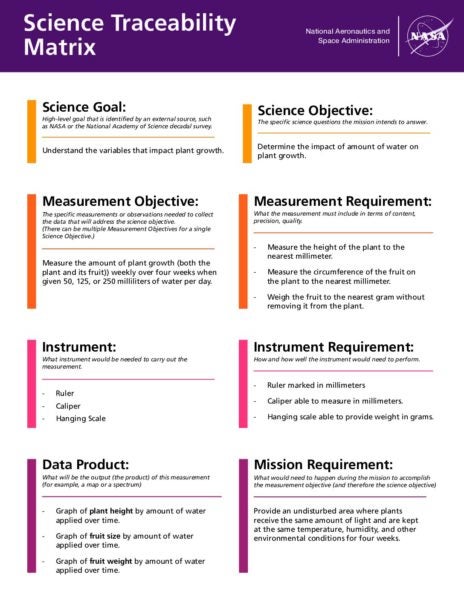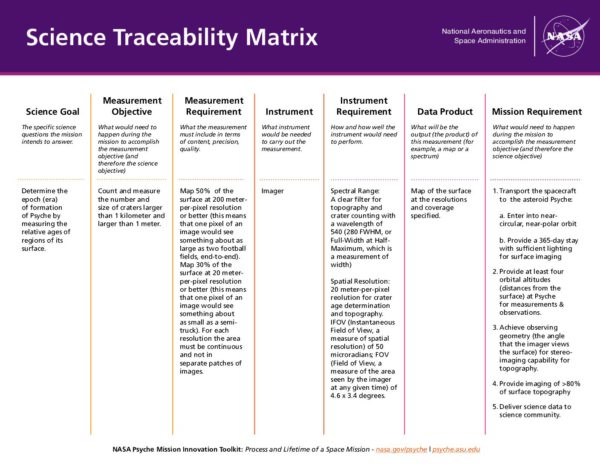Science Traceability Matrix
The NASA science and traceability matrix is meant to break down the steps required in planning goals, objectives, and solutions in space mission development from formulation through completion of implementation in order to stimulate effective decision-making.
NASA also establishes criteria for each NASA-sponsored payload. Four risk classification levels (A thru D) are defined in the NASA Procedural Requirements (NPR). For example:
Science Goal: High-level goal that is identified by an external source, such as NASA or the National Academy of Science decadal survey.
Example: Understand the variables that impact plant growth.
Science Objective: The specific science questions the mission intends to answer.
Example: Determine the impact of the amount of water on plant growth.
Measurement Objective: The specific measurements or observations needed to collect the data that will address the science objective. (There can be multiple Measurement Objectives for a single Science Objective.)
Example: Measure the amount of plant growth (both the plant and its fruit) weekly over four weeks when given 50, 125, or 250 milliliters of water per day.
Measurement Requirement: What the measurement must include in terms of content, precision, and quality.
Examples: Measure the height of the plant to the nearest millimeter.
Measure the circumference of the fruit on the plant to the nearest millimeter.
Weigh the fruit to the nearest gram without removing it from the plant.
Instrument: What instrument would be needed to carry out the measurement.
Examples: Ruler, Caliper, Hanging Scale
Instrument Requirement: How and how well the instrument would need to perform.
Examples: Ruler marked in millimeters
Caliper able to measure in millimeters.
Hanging scale able to provide weight in grams.
Data Product: What will be the output (the product) of this measurement
(for example, a map or a spectrum)
Examples: Graph of plant height by amount of water applied over time.
Graph of fruit size by amount of water applied over time.
Graph of fruit weight by amount of water applied over time.
Mission Requirement: What would need to happen during the mission to accomplish the measurement objective (and therefore the science objective)
Example: Provide an undisturbed area where plants receive the same amount of light and are kept at the same temperature, humidity, and other environmental conditions for four weeks.
Interested in learning more about NASA’s Psyche Mission?
The NASA Psyche Mission Innovation Toolkit includes a series of free online courses based on the real-world challenges and skills associated with the Psyche mission’s science, engineering, technology, and teamwork. Click below to learn more:



